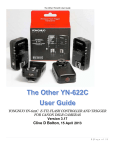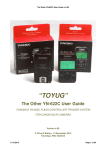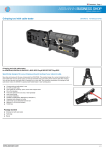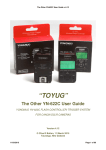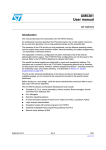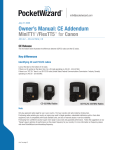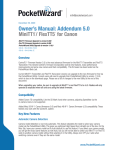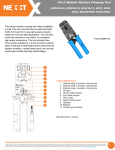Download The Other YN-622C User Guide
Transcript
The Other YN-622C User Guide The Other YN-622C User Guide YONGNUO YN-622C E-TTL FLASH CONTROLLER AND TRIGGER FOR CANON DSLR CAMERAS Version 3.21 Clive D Bolton, 28 August 2013 28/08/2013 Page 1 of 23 The Other YN-622C User Guide INTRODUCTION What we know gets in the way of what we could know. I have used Canon’s Flash Control menus for 5 years, appreciating being able to control remote flashes from the camera. Well, sort of. Canon has been using an optical pulse “wireless” command system for off-camera flashes, which works within a limited set of conditions. Pixel released their King triggers to remove this limit, but their development was truncated. However, kudos to Pixel for pioneering this category of trigger/controller. Now we have the Yongnuo YN-622C which seems to fulfil the promise of a full implementation of Canon flash technologies over a radio link. It seems that Yongnuo has not only achieved this objective, but has added a wide range of triggering and photographer-friendly capabilities. Yongnuo have had a range of hot-shoe flashes, with a degree of unreliability. The design engineer for this device looks like single-handedly rescuing the brand. The YN-622C is a transceiver type radio device designed to go between a camera and one or more off-camera flashes, to provide: • E-TTL, FEC & HSS off-camera triggering • Radio control of off-camera flashes from camera flash control menus • General-purpose triggering There is much (unnecessary) debate about the merit of TTL flash exposure versus Manual power levels. Each method has its place, and photographers who understand the technologies can get predictable results. The YN-622C is a tool for both approaches. One part of Canon’s E-TTL is often misunderstood – Ratios. It is more than setting an FEC or EV adjustment on two flash groups. That still leaves distance, height, angle, relative powers, uneven ambient etc that can make a substantial difference. Canon’s ratio evaluates the actual contribution to the image of each group of flashes, and sets the level accordingly. It is much more accurate than the EV method. The YN-622C implements the genuine Canon technology in the camera. The YN-622C does not provide for firmware updates by the user. Canon Wireless Master/Slave is not available, being replaced by the 622 procedures. The transceiver buttons are hard to find by touch, and are sensitive to accidentally changed settings. Only flashes in group C can be disabled remotely. It is not a significant list of drawbacks. An examination of the case and internal components reveals a high-quality assembly. The case appears firm. I anticipate a good life expectancy. Because the YN-622C is designed primarily to implement Canon technologies, a thorough knowledge of both camera and flash manuals is helpful. Each camera model has its own variations. My verdict: versatile, complex, well-made, suitable for many jobs, and low-priced. Buy it. The author has no association with the manufacturer other than as a paying customer. Some additional samples were received; thanks, Yongnuo. The main testing equipment was EOS 50D, 7D and 6D; Speedlites 580EX II, 430EX II and 550EX; Yongnuo YN-622C triggers; Pixel Soldier as a radio shutter release. 28/08/2013 Page 2 of 23 The Other YN-622C User Guide CONTENTS Introduction Contents Glossary Camera compatibility Type A – Camera menu Control Type B – Flash button Control Type C - Sync Only Flash compatibility Class 1 – Camera-set ETTL and Manual Class 2 – Camera-set ETTL, flash Manual Class 3 – Camera-set ETTL, no manual Class 4 - Sync Only Class 5 - Studio Strobes Getting Started Transmitter on Type A Camera Remote Flashes On-Top Flash PC-sync Flash Factory Reset Testing lighting setup Using a Light Meter First Shots YN Remote & Mix Modes Remote Control Mix Control More creative scenarios Canon Flash Control Menus E-TTL Mode Type A cameras Type B cameras Ratio Flash Exposure Compensation FEC Flash Exposure Lock FEL Flash Exposure Bracketing FEB Manual Mode Remote Manual On-flash Manual Multi Mode (Stroboscopic) Shutter Sync Modes First Curtain Second Curtain Fast-Shutter Sync Simple Trigger Camera Features Ambient-only Shot High-speed Continuous Shooting Live View Modelling Light Flash features Flash zoom / coverage LCD Display Pilot Indicator 622 Features AF-assist beam Sleep Wakeup Status Indicator Group Indicators Using Type B Cameras Using Type C Cameras Suggestions Trouble Shooting Other Resources Specifications Glossary Hot-shoe, Hot-foot, Cold-shoe: The hot-shoe is the accessory fitting on top of camera and transceiver. The hot-foot goes into the hot-shoe, e.g. bottom of a flash or transceiver. A cold-shoe holds a hot-foot without making contact with the pins. Transmitter (TX, Controller): The transceiver when mounted on the camera hot-shoe. (Transceiver will still act as a Receiver to another transceiver on the same channel.) Receiver (RX, Slave): The transceiver when used to connect a flash by hot-shoe or by a PC-sync cable. Remote Flash: A flash connected to a Receiver, by hot-shoe or by cable. On-top flash: A hot-shoe flash mounted on the Transmitter. It has some special features. 622: a convenient abbreviation for a YN-622C Transceiver. 28/08/2013 Page 3 of 23 The Other YN-622C User Guide CAMERA COMPATIBILITY YN-622C “Type A” Camera – Camera Menu Control (2007 and on) Provides remote control of flash settings on class 1 flashes: Flash Mode (E-TTL with FEC, Manual with global level); Shutter Sync (1st curtain, 2nd curtain, HSS/Supersync); Firing groups (E-TTL Ratios, Manual levels); Zoom control; Channels. • 1D III, 1Ds III, 1D 4. Also ID X but Ratios said to be unreliable. • 5D II, 5D III, 6D, 7D • 40D, 50D, 60D • 450D XSi, 500D T1i, 550D T2i, 600D T3i, 650D T4i (100D, 700D not yet tested) • 1000D XS, 1100D T3 • EOS-M (no AF-assist) Provides as above except for Firing Groups (E-TTL or Manual) and Channels. • G12, G15, G1X, SX20 IS, SX30 IS, SX40 HS, SX50 HS, F335 YN-622C “Type B” Camera – Flash Button Control (prior to 2007) ETTL with FEC, Manual output levels, HSS and Supersync. • 1D II (Not 1D or 1Ds) • 5D • 10D, 20D, 30D • 300D D-Rebel, 350D XT, 400D XTi YN-622C “Type C” Camera - Sync only Standard hot-shoe - Synchronised Fire! • Supports single-contact hot-shoe cameras. • Includes many Nikon and other standard ISO hot-shoe cameras. FLASH COMPATIBILITY Most flashes with a standard hot-shoe are “compatible” - they can be triggered synchronously. (The 622 is rated at only 6 volts on the trigger contact of its hot-shoe. The PC-sync connection can withstand 300 volts.) But the YN-622 is bought for its control abilities with a type A camera. A bit of relevant Speedlite history 1. There was an Accessory shoe on camera to mount a device, and a centre-pin contact to fire the flash. All settings were made on-flash. The camera did not know what they were. 2. More pins were added, and TTL, A-TTL, E-TTL and E-TTL II were developed as key flash technologies. The camera became more aware of flash settings. Settings still on-flash. 3. Canon implemented an off-camera system using a Master flash to drive one or more slaves using light-pulse coding. The camera was taught to read the flash settings, and act accordingly. FEC was added to the camera. There was no provision on the camera for setting Manual output levels, so there was no need to implement a path in the flash' s hotfoot. Settings still on-flash. 4. A better interface was required, and in-camera. Canon designed the flash control menus (from 1D-III, March 2007 on) so that the camera could both read and set ALL settings in the flash. This meant major design requirements for the flashes. All flash settings needed to be digital. A path through the flash hot-foot to the processor had to be created which could set, not just read the flash settings. They could now be set on-camera for Mark II and later flashes. The only flashes which can be fully controlled by flash menus are ones that have the required communication through the hot-foot. 5. After the release of the YN-622C, Canon released the 5DIII, ST-E3, 1D X and 600EX-RT, which provide a “radio wireless” facility. This added features like mixed firing modes (ETTL/M/Auto), channels 5-15, Wireless IDs and groups D & E. The 622C cannot use these extensions, and the camera must be in “optical wireless” mode. 28/08/2013 Page 4 of 23 The Other YN-622C User Guide YN-622C “Class 1” – Camera-set E-TTL and Manual Levels Using Flash Control menus: Flash mode (ETTL, M, Multi); Zoom; Sync mode (1st, 2nd, HSS); ETTL functions (FEC, FEB and Ratio); Remote Manual levels. Brand HSS No HSS Canon 580EX II, 600EX-RT. No Multi: 270EX II, 430EX II Jessop Metz 50 AF-1, 58 AF-2, no Multi Nissin Di866 II Yongnuo YN-500EX, YN-568EX YN-465, YN-467, YN-467 II, YN468, YN-468 II, YN-565 II, YN-565EX Phottix Mitros YN-622C “Class 2” – Camera-set E-TTL; Flash-set Manual Levels Set on flash: Flash mode (ETTL, M, Multi); Zoom; Manual levels Using Flash Control menus: Sync mode (1st, 2nd, HSS); ETTL (FEC, FEB, FEL and Ratio). Brand HSS No HSS Canon 550EX, 580EX. No Multi: 430EX Metz No Multi: 48 AF-1, 48 AF-2, 54mz4 (Mix mode, Wireless disabled) Nissin Di866 Di622 II Sigma No Multi: EF 500, 530, 610 DG Super Sunpak No Multi:Z42X YN-622C “Class 3” – Camera-set E-TTL; Manual Levels not provided Brand Canon HSS No Multi: 220EX, 270EX, 320EX, 380EX, 420EX No HSS YN-622C “Class 4” – No E-TTL provided; Flash-set Manual Levels; Sync Only Synchronised up to 1/8000S (Supersync), limited by camera and strobe, otherwise max. 1/250s. • Includes various hot-shoe flashes, including single-contact flashes. • A hotshoe flash with only the centre pin effective will receive only a 1st-curtain sync signal. • A flash connected by a PC-sync cable (including through a PC to Hot-shoe adapter) will receive a 1st-curtain, 2nd-curtain or pre-shutter sync signal. Brand Model Canon 540EZ (updates LCD info.) MeiKe 940 Vivitar 285, 285HV IF trigger voltage is below 12 volts Yongnuo YN460, YN460-II, YN560, YN560-II, YN560EX YN-622C “Class 5” - Studio Strobes: No E-TTL; Flash-set Manual; Sync Only A user-supplied PC-sync cable is required between the remote 622 and the strobe’s input. Strobe receives 1st-curtain, 2nd-curtain and Supersync (pre-shutter HSS) sync signal. First curtain sync at x-sync and slower shutter speed Most studio strobes. HSS (flat light) sync above x-sync shutter speed Cheetah CL180 and CL360; Godox Wistro AD180 and 360; ProMaster/Mettle D400R Supersync, above x-sync shutter speed (From users, gleaned from online sources) • Unusable: Alien Bee 400, 800, 1600; Bowens Travelite; Einstein E640; Elinchrom D-Lite 2. • Usable: Jinbei Discovery 1200w; Pioneer III 600w; Calumet Genesis 300B, Mettle 600ws. 28/08/2013 Page 5 of 23 The Other YN-622C User Guide GETTING STARTED Important • Keep transceivers dry and out of explosive situations. • Turn off power on camera, transceivers and flashes before connecting. • Check that all equipment is installed correctly (fully forward) in the hot-shoe. • Batteries – camera, flash, 622s – are critical. Recharge or replace as required. • Most Flash Control Menu settings (including the AF-assist C.Fn) are saved automatically in, and read from, the on-top 622 • Not stored are FEB, Zoom, E-TTL Fire ratio and Group. C’s FEC, which revert to default values on power-up. Transmitter on Type A Camera Install a 622 on the camera’s hot-shoe: • Back the locking ring up to the transmitter case to withdraw the locking pin. • Mount the 622 in the camera’s hot-shoe. Press the foot firmly forward. • Clamp the locking ring onto the hot-shoe. The locking pin will engage. • Press half-shutter or open External Flash control menu to activate as a transmitter. Set up transmitter using camera menus: Keep the transmitter in Remote Control mode (the default mode). Flashes will comply with the settings in the camera’s Flash control / External flash function menu. • Set Flash firing to Enable. • Select External flash function setting and set desired flash mode, zoom setting etc. • Enable wireless function and set firing group, fire ratio or flash output. (If the Wireless function is disabled, the firing group consists of All (A+B+C), and all groups of flashes use the same global settings. • Set a channel for the transmitter (CH1-CH4 only).using the Wireless function menu. Confirmation of menu setting When a change to the camera menu is successfully applied to a remote flash, the AF-Assist Beam of its 622 receiver will flash twice when the [Set] button is pressed. • The confirmation light will be emitted only if the remote 622 has C.Fn 8 enabled. • Changing the C.Fn 8 setting of the 622 will update only the on-camera unit. • The 622 Factory Reset [CH] + [GP] does not change the C.Fn 8 setting. Remote Flashes Install each flash on the hot-shoe of a Receiver: • Loosen the locking ring or lever on the flash to withdraw the locking pin. • Mount the flash on the 622. Press the foot firmly forward to ensure all contacts are secure. • Tighten the flash’s locking ring or lever. • Mount the 622 direct on a mini stand, or on a light stand using a cold-shoe adapter. Turn on Receiver and set Channel and Group: • Slide Receiver power switch to [ON]. The channel and group indicators light briefly. The Status indicator turns steady red. The flash may fire once when turning the 622 on or off. • Set Receiver to the same channel as the Transmitter, using [CH]. The channel indicator will light for several seconds to indicate the current channel. Quickly press [CH] again to change the channel. • Set the lighting group (A, B or C) for each flash using [GP] for the desired lighting control. Turn Flash on • Check that each flash indicates ready. • Press Pilot/Test on the flash. 28/08/2013 Page 6 of 23 The Other YN-622C User Guide On-Top Flash A flash can be installed on the transmitter on top of the camera. It behaves much like a Remote flash, but there are differences: • Supports E-TTL, Manual levels and Multi (stroboscopic) modes. • The On-top flash output settings follow Group A settings. • The On-top flash has no channel. It is effectively direct-connected to the camera. • The zoom setting is not controlled by the camera menu. It must be separately set on-flash as auto or as a manual level. The zoom setting of the On-top flash can be different than offcamera flashes. E.g. Set the On-top flash zoom to Auto, so that it zooms with the lens. Using the camera flash control menu, set Manual zoom 24mm – 105mm so that off-camera flashes keep a constant setting. • It may provide an AF-assist beam additional to the Transmitter’s AF-assist beam, if that is enabled. PC-sync Flash First curtain, Second Curtain and Fast Shutter (Supersync) syncs are available. Factory Reset If a transceiver seems erratic: • Disconnect the 622 then turn it on. • Hold down [CH SET] plus [GP SET] at the same time. • The Status indicator will wink red-green alternately 3 times, then stay red. • Release the buttons. Factory defaults will be set. • The defaults will be Flash mode: Manual and Sync mode: HSS. If the unit is then placed on the camera, the Flash Control menus will be set to those values. Testing the Lighting Setup The setup can be tested to ensure that all devices are powered up and that the communication is working. In addition, actual lighting outputs can be metered if manual levels are being used. • The [Test] button can awaken the flashes and test whether they can be triggered. • The test works through both hot-shoe and PC-sync cable. • If the flash does not wake, manually awaken it. • Use the PC-sync port to connect a flash which does not have the awakening function. • All 622s (in transmitter or receiver mode) on the same channel as the test unit will be addressed, and those flashes in the “Test Group” will be fired. • An on-top flash will also fire if the 622 transmitter’s Lighting group is included in the test group. • All the indicators go out when flash fires. • The Testing group is not the same as the Lighting group, or the Firing group which controls ratios and levels. • To select a testing group, hold down [Test] and repeatedly press [GP SET] to cycle through the seven testing groups. • To test all flashes, select All (A+B+C). • When the desired testing group is shown, release [Test]. The flashes in the selected group will fire a test flash. 28/08/2013 Page 7 of 23 The Other YN-622C User Guide Using a Light Meter • • • • • • Set Manual levels (or Multi), either by Flash Control menus or by on-flash settings. The test fire will be at the level as it is displayed on the LCD of the flash. The test button will not change the setting of the flash. If Remote control is being used, first press half-shutter to ensure that settings are applied E-TTL will produce a pre-flash, which may confuse the light meter. Trigger with any 622 on the same channel. It may be a hand-held one. First Shots With the 622 transmitter in Remote Control mode, press [MENU] on the camera, and select Flash Control / External flash function setting. • The 622 transmitter’s Status indicator will flash yellow and its CH and GP indicators will flash green to indicate transmitting. The 622 Receivers will flash red and its CH and GP indicators will flash green. They will stay in a live update state until the menu session ends. • Select E-TTL II as flash mode. • When the off-camera flash settings match the camera’s menu, the AF-assist beam of the receiver will wink twice to show that the change is successful. If the parameter which has been changed isn’t supported by the flash (such as hi-speed sync), this function will be abnormal. • Half-shutter to focus, and on the flash screen the aperture and effective range etc. will be displayed. • The AF-assist beam of the transmitter may assist focusing. • Ensure that the subject is in the effective flash range, and fully press shutter button to shoot. • Enable the Wireless function menu to enable firing group control. 28/08/2013 Page 8 of 23 The Other YN-622C User Guide YN REMOTE & MIX MODES The YN-622C can work in either of two modes – Remote or Mix. In Remote mode, the Type A camera’s flash control menus take priority over most on-flash settings. In Mix mode, the on-flash settings take priority. E-TTL and Manual can be mixed. • The transmitter 622 sets the mode. It is not set on the remote 622s. • In Remote Mode, the channel indicator will stay off. In Mix Mode, it will stay lit. • To switch between Remote Mode and Mix Mode, hold down [CH SET] on the transmitter for 3-4 seconds until the channel indicator winks 3 times. • The last-used setting is remembered during power-down. Remote Control Mode • • • • The camera’s Flash Control menu settings take priority, and enforce settings on Class 1 flashes. This is the Factory default mode. Requires a Type A camera for Manual settings. Channel indicator does not stay lit. Examples: Camera + 622 + 580EXII (622 in Remote Mode; flash is in Group A enforced). Two remote 622 + 430EXII. • Set Remote 622s to Group B. Set menu item Flash Mode to ETTL, with FEC if needed. Set Wireless/Firing Group to A:B. Set Fire Ratio to 1:3. The camera will call for pre-flash, evaluate power levels required, and produce a normal exposure from the two Group B flashes, with fill from the on-top flash. FEC and Ratio can be controlled from camera. • Set one remote 622 to Group B and the other to Group C. Set Flash Mode to Manual. Set Wireless/Firing Group to A:B C. Set Group Outputs for A-1/32, B-1/8 and C-1/4. Use B as main, C as background, A as on-camera fill. Group outputs can be set and adjusted remotely as required. Mix Control Mode Creative lighting scenarios can be implemented by switching the 622 system to Mix mode. • Type A and B cameras may be used. • All Classes of flash may be used. • E-TTL / Manual / Multi flash modes may be mixed. • Flash settings take priority. Settings are made manually on each flash • To invoke Mix mode, hold down [CH SET] on the transmitter for 3-4 seconds until the channel indicator winks 3 times. It will then stay lit. • The Remote/Mix setting is remembered by the individual unit on power-down. • Do not try to set or un-set Mix mode using the buttons on receivers. • The Flash mode of the transmitter will be locked in E-TTL mode. • Set each flash (including an on-top flash) to desired flash modes, E-TTL, Manual or Multi. The settings of the flash take priority. • The camera can set only FEC, FEB, Ratio and Shutter sync. • If the shutter sync is set by the camera menu, the on-flash setting is ignored. A type B camera defaults to hi-speed sync. • The camera’s zoom setting is disabled. • Any flash set to E-TTL will emit a preflash. If its mode is Manual or Multi, it won' t. 28/08/2013 Page 9 of 23 The Other YN-622C User Guide More Creative Scenarios Augmenting Ambient Indoor event photographers may use flashes high on light-stands and set to bounce light off the ceiling, or to provide hair- or rim-light. An on-top flash provides on-axis fill/main light for subject. Basic setup • Camera menu set to Firing Group A:B C • Transmitter set to Mix mode. CH indicator shows steady green. • Remote 622’s lighting groups set to B or C. • On-top Class 1 or 2 flash set on-flash to ETTL mode. • Remote Class 1 flashes set on-flash to Manual at say 1/4th power. Remotely adjusting augmenting flashes in Mix mode • Change Transmitter to Remote mode. • In camera menus select Manual mode and adjust output levels for B and C. • Change Transmitter back to Mix mode. • On-top flash re-set on-flash to ETTL mode. Walk-About (APOAZ technique) • On-top flash in ETTL and flashes in Manual to augment. • To be able to turn off triggering of augmenting lights, set remote 622s to say Channel 2. • Set Transmitter to CH 2 to use remote lights, and on-top flash will still fire. • Set Transmitter to CH 1 to use only on-top flash. Remote mode with Class 2 or 3 flashes (Dan Kinzie technique) Instead of using Class 1 flashes in the basic setup above, use Class 2 or 3 flashes like the YN-560. • Camera menu set to E-TTL mode. • On-camera 622 transmitter set to Remote mode. • On-top Class 1 or 2 flash, which adopts menu settings to produce an E-TTL/FEC exposure. • The 560s set on-flash to a manual power level. • The YN-560s will be triggered at their set levels, and will not respond to menu settings. • The maximum sync speed may be 1/250S. Class 5 strobes with Independent Remote Control (David Ward technique) • Place a 622 on the camera, with an on-top hot-shoe flash. • Place a 622 nearby and mount another trigger controller, like the Cybersync Commander. • Mount strobes, e.g. Einsteins, on stands for augmented ambient or rim light. Connect a Cybersync receiver to each. • The Cybersync provides easy remote control of strobes for adjusting power, and the 622 provides triggering of the strobes and full control of any 622-mounted hot-shoe flashes. Two-Shooter Setup (John UK technique) A second shooter can share augmenting flashes. There is a problem – preventing the zooming and firing of the other camera’s on-top flash. • Camera 1 set to E-TTL or Manual, and Firing Group A:B at some ratio/power. • On-camera 622 set to Remote mode and Group C, with an on-top flash. • Camera 2 set up the same. • Enhancing flash stand with remote 622 set to Group B, plus flash. • When either camera takes a shot, it' s on-top flash is treated as Group A, the augmenting flash as Group B, and the other camera as Group C. Group C is not enabled in Firing Group A:B, so does not fire. 28/08/2013 Page 10 of 23 The Other YN-622C User Guide CANON FLASH CONTROL MENUS The camera’s flash control menus are the main interface for using the 622s. The menus change interactively as selections are made. The 622 controls or disables some menu items. • For 6D, 5D III, 650D and other new models, select the optical pulse transmission menu. • See the third page of this section for the new Quick Flash Control panel. Confirmation of Setting When a change to the camera menu is successfully applied to a remote flash, the AF-Assist Beam of its 622 receiver will flash twice when the [Set] button is pressed, to indicate that the change was successful. • Press [SET] after making a menu value change. Don’t have to redo the setting! • The confirmation light will be emitted only if the remote 622 has C.Fn 8 enabled. Starting menu item • Flash Control (or External Speedlite Control) First menu • Flash Firing • External flash func.setting • External flash C.Fn setting • Clear ext. flash C.Fn set. Enable or disable the 622 transmitter. 622 is identified as an external flash. FEB auto cancel – locked Enabled. FEB sequence – locked. AF-assist beam firing – Enabled or Disabled. External flash function menu • Flash mode E-TTL II, Manual, MULTI. (TTL, Auto external, Manual external disabled.) • Shutter sync 1st curtain, 2nd curtain (if Wireless Disabled), Hi-speed • FEB 6 stops in range -6 to +6. Interacts with FEC. • FEC Flash FEC -2 to +2 (later cameras -3 to +3). Interacts with on-flash settings. • E-TTL II Evaluative, Average • Zoom Auto, 24 28 35 50 70 80 105mm (later cameras 200mm) • Wireless Enable, Disable • [INFO] Clear Speedlite settings. 28/08/2013 Page 11 of 23 The Other YN-622C User Guide Wireless Settings • Wireless Function Enable, Disable • Master flash Enable, Disable. On-top flash will emit preflash and focus-assist, but not exposure flash • Channel 1 to 4 Firing Group, in E-TTL II flash mode • A+B+C All E-TTL capable flashes will pre-fire for a combined exposure evaluation. • A:B Set lighting ratio from 8:1 to 1:8, using E-TTL, C is not settable and not fired. • A:B C Lighting ratio 8:1 to 1:8, plus C with exposure comp. -3 to + 3 stops Firing Group, in Manual flash mode • A+B+C All remotely-controllable flashes use Group A, 1/1 to 1/128 in 1/3 stops. • A:B Group A output 1/1 to 1/128 Group B output 1/1 to 1/128 Group C not set or fired • A:B C Group A output 1/1 to 1/128 Group B output 1/1 to 1/128 Group C output 1/1 to 1/128 • Setting for group A will also mirror Flash Output in previous menu page. Flash mode Multi • Flash Output 1/128 to 1/4. 1/1 or 1/2 not available. • Frequency 1 to 100 Hz • Flash Count - - Firing until shutter closes, or battery or lamp fails. 1 to 100 Max determined by Output and Frequency. 28/08/2013 Page 12 of 23 The Other YN-622C User Guide New Quick Flash Control Panel Starting Menu - 6D, 5D III, 650D/T4i Select Camera 2 menu, External Speedlite control item. • Flash Firing Enable or disable the 622 transmitter. • E-TTL II metering Evaluative or Average. • Flash sync speed in AV mode • Flash Function settings Opens Quick Flash Control panel, as below • Flash C.Fn setting. • Clear settings Quick Flash Control panel Displays current settings, and permits changes. The display changes inter-actively. • Add “External Speedlite Control” to “* My Menu”, and move to top. • Enable “Display from My Menu” to start with this menu when [MENU] is pressed. 28/08/2013 Page 13 of 23 The Other YN-622C User Guide E-TTL MODE Automatic Adjustable Metering Type A cameras Camera menus or buttons • All (global), A:B (ratio), A:B C (ratio + FEC) • FEC +/- 2 stops, with on-flash FEC settings adding to the result. • E-TTL modes Evaluative or Average • E-TTL Flashes emit a pre-flash Type B cameras Camera buttons • All (global), no Canon ratio. • FEC +/- 2 stops, with additive on-flash FEC setting • E-TTL modes Evaluative or Average • E-TTL Flashes emit a pre-flash Ratio Canon’s lighting ratio becomes available through the Firing Group settings, when Wireless mode is enabled. This is the true professional multi-preflash “effective reflected light” ratio, not an approximation. • Ensure that the light output requirements are within the capability of the flashes, possibly by increasing ISO, changing distance to subject, etc. • Flashes with different maximum outputs can be mixed. A:B Firing Group • Set the lighting ratio from 8:1 to 1:8 (in 1/2-stop increments) • A “normal” subject exposure will be calculated. • This total exposure can be adjusted by the over-all FEC setting. • The effective reflected light from group A flashes (including on-top flash) and group B flashes will be evaluated by the camera and transmitted to the flashes by the 622. • Group C does not fire. A:B C Firing Group • Set A:B ratio as above. • Set an FEC (-, 0 or +) for flashes in Group C. Flash Exposure Compensation (FEC) The over-all automatic flash exposure can be adjusted using the camera button or flash control menu, combined with the on-flash setting. (This improves on Canon procedures.) • Camera FEC can be set in 1/3-stop increments within 2 or 3, depending on camera. • Each flash has its on-flash FEC added to the camera-calculated output level. E.g. if the camera is set to -2, and the flash is set to +1, then total FEC for that flash will be -1. • Set all on-flash FEC settings to zero, and use only camera FEC, to avoid unexpected results. • Using a lighting group of All (A+B+C), E-TTL can produce uneven lighting with multiple flashes due to differences in ambient light, flash power, distance, angle, etc. One flash can have a small FEC of, say, +1/3 FEC to balance more ambient hitting the other side of the subject. • Using an A:B ratio, the ratio effect will be modified by the individual flash FEC. Under A:B C, C flash can be set to a value, and trimmed by the C FEC menu. Or, Camera -2 FEC plus C flash -2 FEC produces -4 FEC – greater than usual. 28/08/2013 Page 14 of 23 The Other YN-622C User Guide Flash Exposure Lock (FEL) Press the camera’s [FEL] or [*] button to start an FEL action. • The camera must be in a creative mode. • Live View mode must be disabled. • Flash mode must be E-TTL. • Flash metering temporarily changes to Spot metering. The ambient and flash exposures are locked into the camera for 16 seconds, or while [½-shutter] remains pressed. The values are discarded when the shot is taken, or a hi-speed burst ends. • If the subject is too far away and underexposure will result, the < Flash > icon will blink in the viewfinder. Move closer to the subject and try the FE lock again. Flash Exposure Bracketing (FEB) • • • • • Set FEB in 1/3-stop increments within 2 or 3. The zero point for FEB is adjusted by the global FEC setting. The sequence of FEB is fixed at 0 - +, even when the on-flash setting is different. The FEB function will be automatically cancelled after three shots are taken. An E-TTL flash which does not support FEB can also be used. MANUAL MODE Remote Manual Levels Type A camera menus can remotely control Mk II Speedlites and YN flashes. • All (global), groups A and B, or A, B and C. • Power levels 1/1 to 1/128, by Group • E-TTL Flashes do not emit a pre-flash All Flashes (Global setting) • Set Flash Mode to Manual. • Set Flash Output as required, 1/128 to 1/1 power level, in 1/3-stop increments. • Either, Set Wireless function to Disable, or Enable with Firing Group A+B+C. Two and three lighting groups • Set Flash Mode to Manual. • Ignore Flash Output: it will repeat group A setting. • Set Wireless function to Enable. • Set Firing Group to A:B (C will not fire) or A:B C. • Set each Group Output as required, 1/128 to 1/1 power level, in 1/3-stop increments. • On-top flash will fire at group A level, if Master Flash is enabled. On-Flash Manual Levels Type A, B or C cameras can trigger flashes where the output level has been set on-flash. • Flash connected by PC-sync cable. • Power levels set on individual flash. • E-TTL Flashes do not emit a pre-flash 28/08/2013 Page 15 of 23 The Other YN-622C User Guide MULTI (STROBOSCOPIC) MODE Usage is similar to Remote Manual and On-flash Manual. Stroboscopic mode is particularly effective with a highly-reflective subject against a dark background. Consider using a tripod, remote switch and external battery pack. • Set Flash Mode to Multi. • Set desired Flash output, Frequency and Flash count, as provided by the camera. • Flash Count x Hz = minimum shutter duration. • Limit rapid use and allow at least 15 minutes rest between frequent bursts. • E-TTL Flashes do not emit a pre-flash SHUTTER SYNC MODES First Curtain (Front Curtain) • • The “normal” flash sync. ETTL, Manual and Multi Flash modes. Second Curtain (Rear Curtain) The flash fires right before the shutter closes, giving the appearance of forward motion. • The 622 provides 2nd Curtain sync in either ETTL or Manual Flash modes, including with off-camera flashes. • Not in Multi (stroboscopic) flash mode. • Not in Wireless mode (and therefore no group functions available). • Shutter of around 1/30th sec (see your camera guide) through to Bulb. • Camera must be in a Creative mode. Fast-Shutter Sync High-Speed (HSS or FP) • ETTL and Manual Flash modes, syncs with all shutter speeds up to 1/8000th Sec • The camera must support HSS. • If the hot-shoe flash does not support HSS, the max sync speed is 1/250S or less. Supersync (Flash Burn) • Works with many hot-shoe and studio flashes, up to 1/8000th Sec • Connection only through PC-sync port. A PC-sync cord required. • Max. 300v trigger voltage. • Set camera’s shutter sync as Hi-speed sync. • Use manual exposure or shutter-priority mode • For type C camera, the max PC sync speed is 1/250s or less. • A flash on the hot shoe and another connected to the PC-sync port can be used at the same time. Simple Trigger • 28/08/2013 Single-contact camera & single-contact flash triggering (max sync speed is 1/250s) Page 16 of 23 The Other YN-622C User Guide CAMERA FEATURES Ambient-only shot • • Turn transmitter off. 622 settings are remembered when powered up again. Or, use type A camera menu Flash Firing – Disable. High-speed Continuous Shooting • • Trigger keeps up with camera. (Tested at 6.5 fps.) A Flash battery pack is recommended for maintaining flash output consistency. Live View • Silent Mode must not be enabled, as Canon then prevents flash from firing. Modelling Light • Works as designed. All flashes fire, including on-top flash. FLASH FEATURES Flash Zoom (Flash Coverage) Canon provided a flash head zoom to provide lighting just wide enough to cover the lens’s field of view. Consider the zoom as a light modifier, for efficiency or artistic reasons, or because the flashes may be off-camera and lens zoom is irrelevant. The 622 provides more flexibility than Canon’s implementation. This may be affected by Canon’s rules - Wide panel extended: 14mm; Head in Bounce on Auto: --mm; Head in Bounce on Manual: as set; Auto-adjust for sensor size enabled. Zoom Lock An individual flash under remote control can have its zoom setting locked so that it is not controlled by the camera’s zoom menu setting. • Hold down [CH SET] on a 622 Receiver for several seconds until the channel indicator stays lit. (This is the same as setting mix control on a transmitter.) • Adjust the flash zoom setting with the flash control panel (automatic or manual). • Hold down [CH SET] for several seconds to cancel. The channel indicator will go out. Zoom and Remote Control • Remote Control – camera zoom settings apply. Auto; Manual 24 to 105mm (or 200mm). • With automatic setting, focal length of the flash may change with lens focal length. • With manual setting, focal length of the flash supports manual setting within 24-105MM. Zoom and Mix Control • The camera’s zoom menu setting is disabled. • Set each flash’s zoom setting on-flash – Auto, Manual 24 to 105mm (or 200mm). LCD display • Flash zoom, focal length, ISO, shutter speed, FE Lock, HSS indicators change with settings. Pilot Indicator • Individual test fire works. 28/08/2013 Page 17 of 23 The Other YN-622C User Guide 622 FEATURES AF-Assist Beam When using Autofocus under low-light, the AF-assist beam can be emitted automatically to make it easier to autofocus. • The 622 acting as Transmitter will emit the beam when required by the camera. • An on-top flash which has an AF-assist beam function can also emit at the same time. • Neither a 622 Receiver nor an off-camera flash on the receiver will emit the beam. • The beam will not be emitted when Live mode or Face detection mode is used. • The LED laser provides a bright pattern with a 3 to 5 metre range. There is no health risk. • The AF-assist beam can be enabled or disabled in a 622 mounted on the camera by using the camera’s “External flash C.Fn settings”. The setting is saved automatically in the 622. • When a 622 is mounted on a camera, the camera menu will conform to that 622’s AF-beam setting. Sleep Wakeup • • • On ½ shutter or [Test]. Flash must be mounted on hot-shoe, not PC-sync cord. Flash must have a wake-up facility. Status Indicator • • • • • Power-up/self-test/initializing - red flash for several seconds, plus selected CH and GP indicators. Standby - steady red. Battery low – on startup or half-shutter; Status will rapidly wink Red/Green, and the CH and GP indicators will dimly wink also. If the voltage becomes low (total 2.2 volts), the 622 will turn off automatically. Batteries can be too low on startup to trigger this action. 622 Transmitter communicating – green wink. 622 Receiver communicating – red wink. Group Indicators The group LEDs indicate three separate settings at different times. • Receiver Lighting group - briefly on start-up, and when [GP] is pressed. • Camera’s Firing group – when an on-camera 622 is activated as a transmitter by a) pressing half-shutter or b) opening External flash menu. • Test Firing group – when [Test] and [GP] are pressed. An on-top flash has no group indication. It is deemed to be in group A, and uses A’s settings. Receiver Lighting Groups • Every 622 belongs to one Receiver lighting group, A - default, B or C. • The last-used lighting group is remembered on power-down. Camera Firing Group • The Firing group is set using the camera’s External Flash/Wireless menu settings. • When the 622 transmitter is activated, the group indicators will wink as follows None Wireless disabled (stand-alone mode) A LED Wireless enabled, Firing group A+B+C (All) B LED Wireless enabled, Firing group A:B C LED Wireless enabled, Firing group A:B C Testing Groups • [Test] and [GP] shows the groups that will be test-fired (A, B, C, AB, AC, BC, ABC -default). • An on-top flash will be included in its 622’s lighting group, which may be group A, B or C. 28/08/2013 Page 18 of 23 The Other YN-622C User Guide USING TYPE B CAMERAS As there is no flash control menu, some functions will be restricted. • Install a 622 in the camera’s hot-shoe, so that it auto-selects Transmitter mode. • Enable Mix control mode on the transmitter. ([CH SET] for several seconds.) • Use [CH SET] to set the communication channel. • Press half-shutter. The Status indicator winks green. Press [GP SET] to set firing groups to be used. • Set the required flash mode (E-TTL, Manual, Multi) using the flash’s control panel. • E-TTL mode supports automatic flash, including FEC and FEB. It defaults to hi-speed sync. • Manual (M) mode requires flash output to be manually set on-flash. It defaults to hi-speed sync. • Multi mode requires several parameters to be set on-flash. USING TYPE C CAMERAS Manually set the Flash Output • Set the Transmitting group(s) for the 622 transmitter. Hold down [Test] and repeatedly press [GP SET] to cycle through the seven groups. When the desired group is shown, release [Test]. This is the same procedure as selecting a testing group for the [Test] button. • Set the Flash mode to Manual (M) using the flash’s control panel. • Does not support hi-speed sync or other E-TTL functions. • Max speed sync is 1/250s or less. SUGGESTIONS Batteries Alkaline batteries start at 1.5 volts and hold their voltage until the very end. Rechargeables at 1.2 volts are already 20% down, and approaching the threshold for the 622. Alkaline characteristics are well suited to this type of device, with a 60-hour standby time. (NiMH batteries are great as flash batteries, being capable of a rapid discharge into the capacitor.) Battery Orientation Flashes are often used in low light. It can be hard to read the embossed polarity markers at the bottom of the recess. Use a silver marker pen to highlight the two [+] markers. Camera’s Custom Menu Set up the Flash Control menu as a Custom Menu item, and make the Custom Menu the first up. Hybrid Mode - Master and Slave with 622s Use two 622s to bridge the distance from camera, and Canon Wireless to fire 2 or more flashes. • Only Manual mode can be used. Set camera to Manual flash mode, 1CS or HSS. • Place a 622 on-camera. • Use a non-controllable Master flash (e.g. 580EX) directly on the other 622, or a controllable Master flash (e.g. 580EXII) connected by i) an adapter which has only two wires between hot-foot and hot-shoe, or ii) a PC-sync cord to an adapter foot. • Set the Master flash on-flash as Master, Manual mode and power level, 1CS or HSS. Groups are probably not available (untested). • Set the other flash (e.g. 430EX) to Slave and E-TTL. Ensure the slave’s wireless sensor can see the master’s flash head. Test fire. The 622s should communicate, and the remote 622 will fire the Master. In turn, the slave should change to a manual power level and fire. Try with a different Manual level on the Master. 28/08/2013 Page 19 of 23 The Other YN-622C User Guide Supersync Images Supersync images may benefit from the application of the Gradient tool in post-processing. Wireless Mode Setting Keep this setting at Enabled, and disable it only when 2nd curtain sync is required. (5D II and IIII, and possibly others, change the sync timing if Wireless is Disabled.) Umbrella Mount I recommend a lie-flat bracket for safety, stability and on-axis light beam especially for a softbox or umbrella. To secure the flash, use a Frio Cold Shoe, an American product. (See the blue mounting clip in the images below.) A home-made mount for one flash using a cheap ball swivel and a Frio. A two-flash adaptation of the single bracket. It has two cross-bars added and uses a standard umbrella swivel. A commercial mount is the Link-Delight Speedlite T bracket with Bowens S mount and swivel. Requires a DIY flash-head support. 28/08/2013 Page 20 of 23 The Other YN-622C User Guide TROUBLE SHOOTING Full-power flash • This can happen if the shutter release is fully pressed before the system has aligned every component. The Fire! command can over-ride any setting up in progress. • On startup or on any major adjustment to remote flashes, press half-shutter and release to force system updating. Erratic Behaviour • Unmount all equipment, then re-mount ensuring the hot-foot is pressed fully in. • Replace the batteries in the 622s, preferably with Alkaline ones. Make no assumptions. • Reset the 622s to factory default settings. (Hold [CH SET] and [GP Set] until the Status indicator flashes red/green three times, then release. • Reset your Speedlite. Instal the Speedlite directly on a type A camera, and reset the flash using the menus “Flash Control / Ext Flash Function settings / Clear Speedlites Settings” and "Flash Control / Clear External Flash C.Fn settings", which re-set most main and C.Fn settings. • Reset the factory settings of the camera. Fails to power on or automatically shuts down • The batteries are installed incorrectly or are exhausted. The device will power down automatically before the battery is fully depleted to avoid being over-discharged. • Install fully charged batteries according to the battery compartment indicators. • Battery low – on startup or half-shutter; Status will rapidly wink Red/Green, and the CH and GP indicators will dimly wink also. If the voltage becomes low (total 2.2 volts), the 622 will turn off automatically. Batteries can be too low on startup to trigger this action. The flash does not fire • Ensure the batteries of all devices are fully charged, and flash is recycling in time. • Check the connection between the 622 and camera, and 622 and flash. • Ensure that the indicators show matching channels and lighting groups. • Check that flash is not disabled by its overheating protection, is not in continuous zoom adjustment, or in sleep status. • Use the Pilot button to test the flash. Can't access the external flash function menu • The transmitter is not installed correctly. Re-seat. • The contacts of the hot shoe are dirty. Clean both sets of contacts, including the rails • The battery is exhausted. Replace. The on-top flash doesn't fire • Enable the Master Flash firing in the wireless menu setting. Can't set the flash zoom via camera menu • When the Mixed Control mode has been set in the transmitter, or zoom locking has been set in the receiver, zoom can' t be set via camera menu. • The Zoom setting of the on-top flash needs to be set separately. Unable to set channel 5, 6, 7 via camera menu • The camera can only set channels 1 to 4. Set other channels using [CH SET].. 28/08/2013 Page 21 of 23 The Other YN-622C User Guide E-TTL underexposure or overexposure: • Suggest enabling wireless flash function when using E-TTL flash mode, and adjust the position of the flash, use FEC/FEL function, check flash’s effective range. • It may overexpose when E-TTL and manual flash are used at the same time; the manual flash suits being used as a backlight. Can’t disable selected firing groups With canon cameras, you can only disable group C by selecting "firing group" to A:B. Group A/B is always fired no matter whether you select "ALL", "A:B", "A:B:C" or disable Wireless function. Aperture, distance are not displayed on the flash when half pressing the shutter • Set compatible flash mode/shutter sync with the flash on the transmitter. Flashes are emitting an unwanted pre-flash • If the flash’s mode is E-TTL, it will emit a preflash. If the flash’s mode is Manual or Multi, it won' t. OTHER RESOURCES Getting the Most from Speedlites Pt 1 (10 pages), Syl Arena, Canon Europe http://cpn.canon-europe.com/content/education/technical/getting_the_most_from_speedlites.do Two excellent books: Speedliter’s Handbook: Learning to Craft Light with Canon Speedlites, Syl Arena, Peachpit Press Mastering Canon EOS Flash Photography, N K Guy, Rocky Nook About Shutters and Syncs http://photography-on-the.net/forum/showthread.php?p=15603404#post15603404 Large thread on POTN: http://photography-on-the.net/forum/showthread.php?t=1212530 Yongnuo’s Company Stores Direct Online: http://en.yongnuo.com.cn/ Ebay: http://stores.ebay.com/hkyongnuophotoequipment Dan Kinzie’s video review: http://youtu.be/NTUuFGTHskY User Manual online: https://docs.google.com/open?id=0B77OmmGIg0gMYTNTWEhIOXZNYlU Current version of this document https://docs.google.com/open?id=0B77OmmGIg0gMVFpqNkpBYXBHajA Deutshe translation of this document by J. Wahl https://docs.google.com/open?id=0B__QoUj_xlYSNUpQdnhFbE91LTA 28/08/2013 Page 22 of 23 The Other YN-622C User Guide SPECIFICATIONS Standard Pack • 2 x Transceivers, auto-switching between transmitter/controller and receiver/slave • Quick Start Guide • User Manual • Some resellers may offer single or multiple units. Transceiver Dimensions • 90 x 53 x 25mm (39mm incl. hot-foot). • 79gm without batteries Electrical • Batteries: each unit requires 2x AA batteries (1.5v Alkaline or 1.2v NiMH) • Standby time: 60 hours. • 6 volts maximum safe trigger voltage on hot-shoe centre pin • 300 volts maximum safe trigger voltage on PC-sync port • Digital FSK 2.4GHz radio transceiver. Range 100m (300ft), 7 channels. Connectors • Canon Hot Foot with locking ring and pin, for connecting to camera as transmitter • Canon Hot Shoe for mounting hot-shoe flash, including on transmitter • PC-Sync screwlock socket, sync out only (1st, 2nd, Supersync) Controls • Power switch Off/On • CH Set Button 7 channels C1, C2, C3, 4 (C1+C2), 5 (C1+C3), 6 (C2+C3), 7 (C1+C2+C3) • GP Set Button group (single) A, B, C, (combined) AB, AC, BC, ABC on Transmitter; Group (single) A, B or C on Receiver • Test Button - press to awaken flash; release to fire test flash. GP changes group being tested. (Includes testing via PC port.) Indicators • Status LED: Red – standby; Green operating; send/receive data. • 3x Channel LEDs: communicating, indicating channel • 3x Group LEDs: communicating, indicating group Other fittings • Red AF-Assist beam, enabled only on Transmitter. Strong cross-hatched pattern. • Battery cover • Eyelet for attaching a safety lanyard Provide-your-own extras • Batteries, safety lanyard, PC-sync cord, mini-stand, light-stand cold-shoe This document is copyright C D Bolton 2012 - 2013 and all moral rights are asserted. It may be shared and quoted freely, but not altered. Many thanks to those who provided information incorporated in it. All registered trademarks in this user guide are the property of their respective owners. Specifications and functions may change without notice. 28/08/2013 Page 23 of 23
























